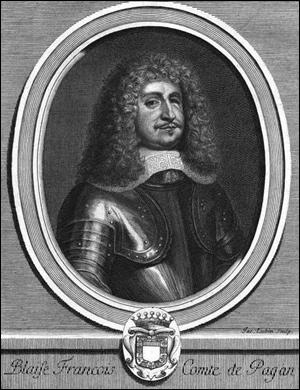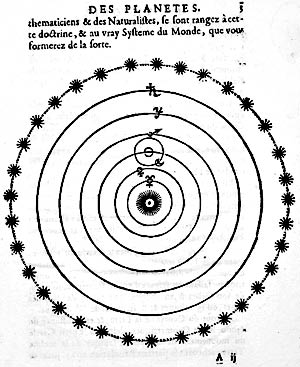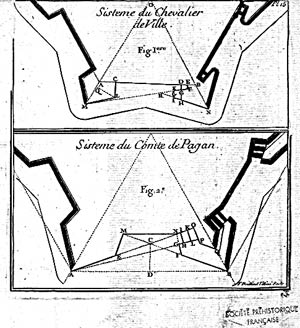Blaise Pagan

(Saint-Rémy-en-Provence, 1604-Paris, 1665)
Blaise François Pagan, a French army engineer and Vauban's teacher, founded France's first fortification school with Errard de Bar-le-Duc and Antoine Deville. He wrote L'Art de la fortification, where he incorporated the bastion into the fortification's ground plan. Blaise François, Comte de Pagan, was born in Saint-Rémy-en-Provence, near Avignon.
His family, of Neapolitan origin, was a branch of the house of Luynes. At a very young age he entered into the service of Louis XIII as an army engineer. The young nobleman participated in the siege of Caen and the battle of Ponts-de-Cé in 1620, the sieges of Saint-Jean-d'Angély and Clérac in 1621 and, in 1622, the capture of Navarreins and Montauban, where he lost his left eye. In 1623 he was an engineering officer during the siege of Nancy. Pagan won fame during the 1629 siege of Suse when he led French troops across the barricades surrounding the town. During the Thirty Years War he worked with Deville at the sieges of Corbie, Landrecies and Hesdin. Pagan also participated in the sieges of La Rochelle and served in Italy, Picardy and Flanders.
Pagan went blind in 1642. He was promoted to maréchal-de-camp, but abandoned his military career and spent his retirement studying mathematics, history, geography, astronomy and the art of fortification. In his Treatise on Fortifications (1645), Pagan described where to locate the most exposed bastions' salients in order to adapt them better to the terrain. Building fortification works outside the walls, he argued, would help space out deep defence and slow down an attack on the main fort. The bastions' flanks are perpendicular to the line of defence to obtain perfect reciprocal flanking. From that point of view he differed from Deville, who maintained that bastions were just added, isolated forward works later connected to the fort. Heavy artillery would ensure defence. He recommended up to 30 cannons per bastion on three levels. The outside included a covered walkway with a small parade ground on the counterscarp (principle of active defence). He advised using the space between the couvre-faces and main wall for the surrounding villages' residents to camp in. His ideas remained theoretical until Vauban incorporated them into his first defence system.
Pagan was also an astronomer and conceived a theory of the planets. He presented his work in Théorèmes des planètes (1657), Les Tables astronomiques (1658) and Astrologie naturelle (1659). A mathematician as well, he wrote Théorèmes géométriques in 1651. His other writings include Relation de la rivière des Amazones (1658) and Œuvres posthumes (1669). In 1652 Pagan was sentenced to eight years in the Bastille for "boasting that he would make the King die by magic". He spent the rest of his life there, forgotten by the king and Cardinal Mazarin. "I am a sick, old man of 78 years..." he wrote in his last letter, dated 28 November 1665. "One day Your Excellency... will learn that I was found phtisical and frozen to death; in this weather I have no fire in my room, and what's more I am barely dressed. I beseech Your Excellency to remember that I have been here 13 years and 12 days, and to beg the King our lord, for the love of God, to give me liberty so that I may go home."

Page extraite de la Théorie des planètes : sistème du monde de Copernic. Source : Gallica.bnf.fr Page extraite de la Théorie des planètes : sistème du monde de Typhon Brahé. Source : Gallica.bnf.fr

Eléments de fortification, contenant les principes et la description raisonnée des différents ouvrages qu'on emploie à la fortification des places de Guillaume Leblond. Système du Chevalier de Ville. Système du Comte de Pagan.
Source : Wikipedia Commons - domaine public

